
Thomas Becket, also known as Saint Thomas of Canterbury, Thomas of London and later Thomas à Becket, served as Lord Chancellor from 1155 to 1162, and then as Archbishop of Canterbury from 1162 until his death in 1170. He engaged in conflict with Henry II, King of England, over the rights and privileges of the Church and was murdered by followers of the King in Canterbury Cathedral. Soon after his death, he was canonised by Pope Alexander III. He is venerated as a saint and martyr by the Catholic Church and the Anglican Communion.
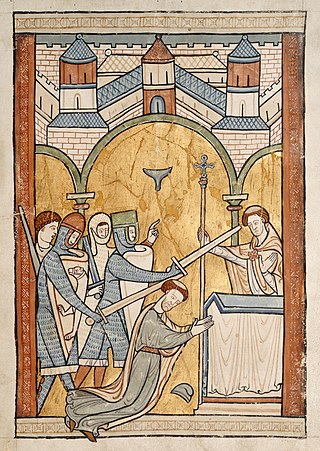
Sir Richard le Breton or Richard de Brito was one of the four knights who in 1170 murdered Thomas Becket, Archbishop of Canterbury.

Knaresborough is a market and spa town and civil parish on the River Nidd in North Yorkshire, England. It is three miles east of Harrogate and was in the Borough of Harrogate until April 2023.
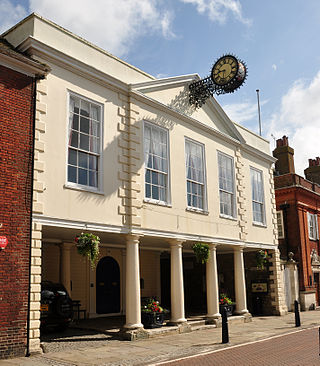
Hythe is a market town and civil parish on the edge of Romney Marsh in Kent, England. Hythe is an Old English word meaning haven or landing place.
Hugh de Puiset was a medieval Bishop of Durham and Chief Justiciar of England under King Richard I. He was the nephew of King Stephen of England and Henry of Blois, who both assisted Hugh's ecclesiastical career. He held the office of treasurer of York for a number of years, which led him into conflict with Henry Murdac, Archbishop of York. In 1153, Hugh was elected bishop of Durham despite the opposition of Murdac.

The Lord High Constable is a hereditary, now ceremonial, office of Scotland. In the order of precedence of Scotland, the office traditionally ranks above all titles except those of the royal family. The Lord High Constable was, after the King of Scots, the supreme officer of the Scottish army. He also performed judicial functions as the chief judge of the High Court of Constabulary. From the late 13th Century the Court – presided over by the Lord High Constable or his deputies – was empowered to judge all cases of rioting, disorder, bloodshed and murder if such crimes occurred within four miles of the King, the King's Council, or the Parliament of Scotland. Following James VI's move to England, the jurisdiction of the Lord High Constable was defined in terms of the "resident place" appointed for the Council.

Lanzelet is a medieval romance written by Ulrich von Zatzikhoven after 1194. It is the first treatment of the Lancelot tradition in German, and contains the earliest known account of the hero's childhood with the Lady of the Lake-like figure in any language. The poem consists of about 9,400 lines arranged in 4-stressed Middle High German couplets. It survives complete in two manuscripts and in fragmentary form in three others.
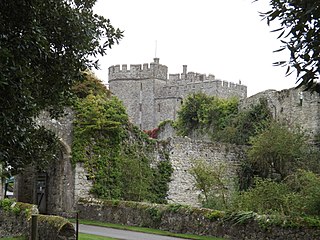
Saltwood Castle is a castle in Saltwood village, one mile (2 km) north of Hythe, Kent, England. Of 11th century origin, the castle was expanded in the 13th and 14th centuries. After the Norman Conquest, the castle was appropriated by the Archbishop of Canterbury Lanfranc and remained the property of the archbishops, with some interruptions, until 1540, when Thomas Cranmer was compelled to cede it to Henry VIII. The castle is reputed to have been the meeting place of the four knights who carried out the assassination of Thomas Becket in 1170. By the 19th century, it was "largely ruinous" and restorations to make portions of the castle habitable were carried out in the 1880s and 1930s. In the late 19th century, the castle was bought by an ancestor of Bill Deedes, the journalist and politician, who grew up there. In the 20th century, it was sold to Sir Martin Conway who commissioned Philip Tilden to undertake a restoration. In 1953, the castle was bought by the art historian Kenneth Clark (1903–1983), and then became the home of his son, the politician and diarist, Alan Clark (1928–1999). It remains the private home of his widow, Jane Clark. The castle is a Grade I listed building.

Sir William de Tracy was a knight and the feudal baron of Bradninch, Devon, with caput at the manor of Bradninch near Exeter, and was lord of the manors of Toddington, Gloucestershire and of Moretonhampstead, Devon. He is notorious as one of the four knights who assassinated Thomas Becket, Archbishop of Canterbury, in December 1170.
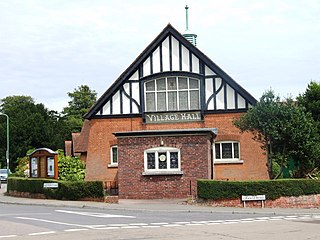
Saltwood is a village and civil parish in the Folkestone and Hythe District of Kent, England. Within the parish are the small hamlets of Pedlinge and Sandling.
Hugh de Morville of Appleby in Westmorland, England, hereditary Constable of Scotland, was a Norman knight who made his fortune in the service of David FitzMalcolm (d.1153), Prince of the Cumbrians, later King of Scotland.

Sir Reginald FitzUrse (1145–1173) was one of the four knights who murdered Thomas Becket in 1170. His name is derived from Fitz, the Anglo-Norman French term meaning "son of" and urse meaning a bear, likely the nom de guerre of an ancestor. Although he lived before the true age of heraldry, which developed in the early 13th century, his shield bore the cognizance of a bear, which is visible in a contemporary drawing portraying the murder of Becket.
Four Nights in Knaresborough is a play written by Paul Corcoran and first performed at the Tricycle Theatre, London in 1999. It recounts the aftermath of the murder of Thomas Becket by four knights making "the worst career choice in history". Despite being an historical drama, the play uses modern language, including an abundance of profanity and slang.
Events from the 1170s in England.

Vipont is the name of a prominent family in the history of Westmorland. According to Thomas the name originated in France before 1066 as Vieuxpont, Latinized to de Vetere Ponte, with alternative spellings Vezpont, Veepon, Vexpont, Vypont, Vispont, Vypunt, Vespont, Vipond, Vypond, Voypond, Veepond, Vippond, Vipon, Vipan, Vipen, etc. The Vipont family bore arms: Gules, six annulets or 3:2:1, later quartered by Baron Clifford.
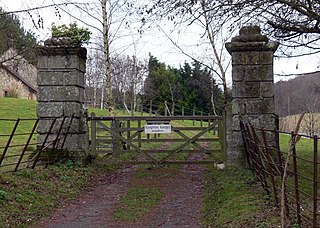
Knighton Gorges Manor was one of the grandest manor houses on the Isle of Wight, located in the hamlet of Knighton, near Newchurch.
Ranulf de Broc was an Anglo-Norman nobleman and royal official during the reign of King Henry II of England. He held two offices in the royal household as well as performing other administrative duties for the king. During the Becket controversy between King Henry and Thomas Becket, the Archbishop of Canterbury, de Broc supported the king and was granted the administration of the exiled archbishop's lands during the later half of the 1160s. This earned de Broc three sentences of excommunication from the archbishop because of de Broc's financial exactions from the estates. De Broc was with the four men who murdered Becket in December 1170, although he did not take part in the actual murder. At de Broc's death around 1179, he left behind a widow and five daughters, who were his co-heiresses.
Clarembald was a medieval Benedictine monk and abbot-elect of St Augustine's Abbey in Canterbury, Kent.

"Will no one rid me of this turbulent priest?" is a quote attributed to Henry II of England preceding the death of Thomas Becket, the Archbishop of Canterbury, in 1170. While the quote was not expressed as an order, it prompted four knights to travel from Normandy to Canterbury, where they killed Becket due to an ongoing dispute between crown and church. The phrase is commonly used in modern-day contexts to express that a ruler's wish may be interpreted as a command by his or her subordinates. It is also commonly understood as shorthand for any rhetorical device allowing leaders to covertly order or exhort violence among their followers, while still being able to claim plausible deniability for political, legal, or other reasons.
Henry St Clair, Lord Herdmanston and Carfrae, was a Scottish noble of the 12th century.










